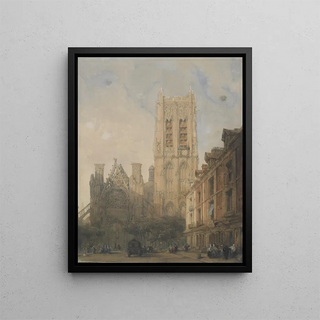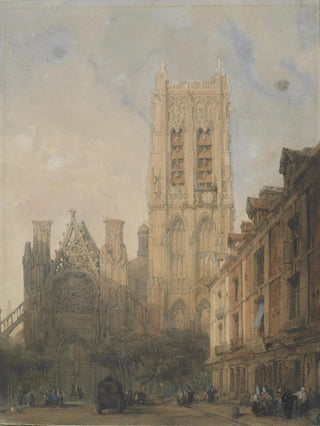Art print | Saint-Jacques de Dieppe Church - David Roberts


View from behind

Frame (optional)
Reproduction of Saint-Jacques Church in Dieppe - David Roberts – Captivating Introduction
The artwork "Saint-Jacques Church in Dieppe" by David Roberts immerses us in the atmosphere of the 19th century, a period marked by the rediscovery of landscapes and iconic monuments across Europe. Through his painting, Roberts does more than simply depict a building; he invites the viewer to explore a rich historical and cultural dimension. The church, with its flamboyant Gothic architecture, stands majestically, bearing witness to Norman architectural heritage. This painting is much more than a mere image: it is an open window to a bygone era, a place of reflection and history, where each stone tells a story.
Style and uniqueness of the artwork
David Roberts' style is characterized by striking realism, combined with romantic sensitivity. In "Saint-Jacques Church in Dieppe," he manages to capture light in a way that imparts unprecedented depth to his subject. The delicate shades of blue and gray create an almost ethereal atmosphere, while the meticulous details of the architecture reveal a deep respect for heritage. Roberts excels in depicting textures, whether it is the aged stone of the church or the surrounding foliage, adding a tactile dimension to his work. This painting perfectly illustrates the artist's ability to marry architectural accuracy with poetic interpretation, paying homage to the timeless beauty of the edifice.
The artist and his influence
David Roberts, born in Scotland in 1796, was a painter and lithographer whose work profoundly influenced landscape art and travel illustration in the 19th century. An indefatigable traveler, he journeyed through Europe and the Middle East, documenting his experiences through works that combine precision and sensitivity. His innovative approach paved the way for a new way of perceiving landscapes, where the sublime and the picturesque meet. Roberts was able to capture the spirit of the places he visited, and his work inspired many contemporary and future artists. By depicting historic sites such as the church in Dieppe, he not only contributed to their preservation but also to their recognition as cultural treasures.

Matte finish

View from behind

Frame (optional)
Reproduction of Saint-Jacques Church in Dieppe - David Roberts – Captivating Introduction
The artwork "Saint-Jacques Church in Dieppe" by David Roberts immerses us in the atmosphere of the 19th century, a period marked by the rediscovery of landscapes and iconic monuments across Europe. Through his painting, Roberts does more than simply depict a building; he invites the viewer to explore a rich historical and cultural dimension. The church, with its flamboyant Gothic architecture, stands majestically, bearing witness to Norman architectural heritage. This painting is much more than a mere image: it is an open window to a bygone era, a place of reflection and history, where each stone tells a story.
Style and uniqueness of the artwork
David Roberts' style is characterized by striking realism, combined with romantic sensitivity. In "Saint-Jacques Church in Dieppe," he manages to capture light in a way that imparts unprecedented depth to his subject. The delicate shades of blue and gray create an almost ethereal atmosphere, while the meticulous details of the architecture reveal a deep respect for heritage. Roberts excels in depicting textures, whether it is the aged stone of the church or the surrounding foliage, adding a tactile dimension to his work. This painting perfectly illustrates the artist's ability to marry architectural accuracy with poetic interpretation, paying homage to the timeless beauty of the edifice.
The artist and his influence
David Roberts, born in Scotland in 1796, was a painter and lithographer whose work profoundly influenced landscape art and travel illustration in the 19th century. An indefatigable traveler, he journeyed through Europe and the Middle East, documenting his experiences through works that combine precision and sensitivity. His innovative approach paved the way for a new way of perceiving landscapes, where the sublime and the picturesque meet. Roberts was able to capture the spirit of the places he visited, and his work inspired many contemporary and future artists. By depicting historic sites such as the church in Dieppe, he not only contributed to their preservation but also to their recognition as cultural treasures.






